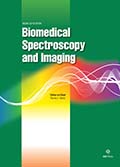Authors: Xu, Chang-Hua | Chen, Jian-Bo | Zhou, Qun | Sun, Su-Qin
Article Type:
Research Article
Abstract:
An approach, macro-interpretation based on FT-IR and 2DCOS-IR, has been developed for TCM classification and identification. It has been noted that every TCM has respective unique IR and 2DCOS-IR macro-fingerprints, every category (protein-rich, oil-rich, tannin-rich, inulin-rich, starch-rich, sucrose-rich and stachyose-rich) of TCMs, however, has common macro-fingerprints in specific wavenumber regions. Particularly, protein-rich TCMs have two strong absorption bands of amide I (~1630 cm−1 ) and amide II (~1560 cm−1 ) in the range of 1680–1500 cm−1 ; oil-rich TCMs generally have characteristic regions with strong autopeaks around 2920 cm−1 , 2852 cm−1 and 1740 cm−1 ; starch-rich TCMs have
…a common pattern of positively correlated strong autopeak cluster (1139 cm−1 , 1120 cm−1 , 1102 cm−1 , 1070 cm−1 , 955 cm−1 , 907 cm−1 , 887 cm−1 ) in the saccharide vibration regions; inulin-rich TCMs have a tower-like fingerprint with the strongest peak around 1033 cm−1 in the region of 1200–800 cm−1 in IR spectra and a 3*3 positively correlated strong autopeak cluster (1006 cm−1 , 954 cm−1 , 893 cm−1 ) in 2DCOS-IR spectra. 2DCOS can enhance the spectral resolution in discriminating TCMs with high similarity in IR spectra. Based on the results of IR and 2DCOS-IR spectral macro-interpretation, TCM classification and identification can be achieved as general character for classification, specific character for identification.
Show more
Keywords: Infrared spectroscopy (IR), two-dimensional correlation infrared spectroscopy (2DCOS-IR), traditional Chinese medicine (TCM), classification, identification
DOI: 10.3233/BSI-150112
Citation: Biomedical Spectroscopy and Imaging,
vol. 4, no. 2, pp. 139-158, 2015
Price: EUR 27.50





